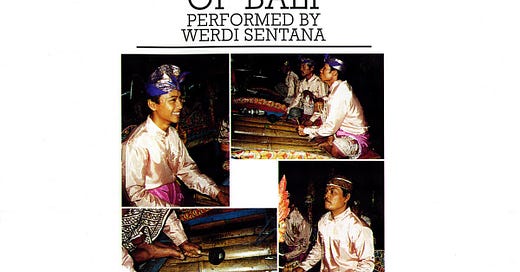Genre of the Day - Gamelan jegog 🇮🇩
Album of the Day - Jegog: The Bamboo Gamelan of Bali by Werdi Sentana (1991)
August 9, 2024
Indonesia alert! <3 🇮🇩
I tend to denote Indonesian genres with a little special flair because back in January, I was rejected for a potential chance to go to Indonesia over the summer in a language program. Though that memory has faded, one wonderful benefit of this project is that I’ve still gotten a chance to travel, via the sonic plane rather than the physical one, to Indonesia and beyond. Today’s is our third entry into the world of gamelan ensembles, Indonesia’s most ornate and storied musical tradition.
The form takes on many shapes throughout the archipelago, from gamelan beleganjur’s spirit-shaking percussive speed to gamelan semar pegulingan’s king-lulling silkiness. While today’s gamelan ensemble may not have as dramatic a sense of purpose, the size and nature of its instruments carry their own grandeur. Gamelan jegog refers to gamelan ensembles played on instruments made entirely of bamboo, reminiscent of Hmong folk music’s leaf songs as another testament to natural resources’ abundant musical capacities. Bamboo’s stature in Indonesia is massive; it’s a material godsend for cloth and paper, several dishes include bamboo shoots, it’s sculpted and burned in Balinese rituals, and in today’s genre that outsized role dazzles on stage.
Gamelan jegog originated in Bali’s southwest corner in the early 1900s, a considerably recent development in gamelan’s millennia-spanning history. Though many gamelan ensembles were traditionally employed in royal courts or religious ceremonies, gamelan jegog is closer to a form of folk entertainment. The sheer size of gamelan jegog’s pieces are already impressive—the style is named for the jegog, the largest and deepest instrument in the ensemble—its bamboo tubes extend up to nine meters. To properly play, two players must come together to properly take on the mammoth instrument. Across the range of gamelan jegog’s marimba-esque bamboo keys, players use heavy mallets to forcefully strike a tune out of the hardened stalks. Gamelan jegog is intense and as fast-paced as bamboo’s famous growth rates, owing to the fact that it’s often played in contests between ensembles. The ensemble that can play at the most booming volume with the most impressive approach wins as chosen by an audience, and players certainly rise to the occasion—some 35% of jejgog ensemble members endure hearing loss for the craft. It isn’t simply a wall of noise, though—the fourteen different sizes each possess a particular melodic, rhythmic, and interlocking purpose. In efforts to prove persistence, uninterrupted jegog performances extend to great lengths.
Today’s album is a veritable exploration of unique, environmentally-derived soundscapes and timbres—though the wind rustling through bamboo leaves might be relaxing, harnessing the plant for musical purpose takes listeners to riveting, uncharted territory. Listening in isolation may not quite reach the live excitement of watching two ensembles attempt to out-jegog one another, but getting lost in the distinctive resonance of these instruments and their hollow yet bright patterings with a fascinating underlying bass tone is nonetheless absorbing. Though it’s more folk-oriented than other gamelan ensembles, classical sensibilities remain in a tactful sense of dynamics—there are barely perceptible, quiet portions that rocket into rapid-fire attacks and oscillations between interlocking syncopation and moments of marching uniformity. It suggests that a dose of healthy competition in music can generate dynamic musical creativity, powered by bamboo’s endless capabilities.





